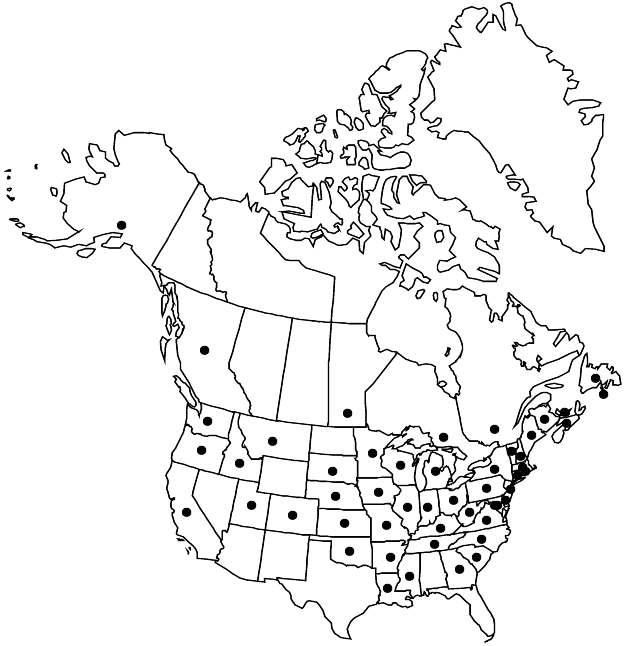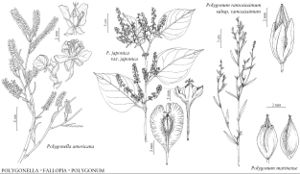Difference between revisions of "Fallopia japonica var. japonica"
FNA>Volume Importer |
imported>Volume Importer |
||
| (4 intermediate revisions by 2 users not shown) | |||
| Line 1: | Line 1: | ||
{{Treatment/ID | {{Treatment/ID | ||
|accepted_name=Fallopia japonica var. japonica | |accepted_name=Fallopia japonica var. japonica | ||
| − | |accepted_authority= | + | |accepted_authority= |
|publications= | |publications= | ||
| + | |special_status={{Treatment/ID/Special_status | ||
| + | |code=W | ||
| + | |label=Weedy | ||
| + | }}{{Treatment/ID/Special_status | ||
| + | |code=I | ||
| + | |label=Introduced | ||
| + | }}{{Treatment/ID/Special_status | ||
| + | |code=F | ||
| + | |label=Illustrated | ||
| + | }} | ||
|basionyms= | |basionyms= | ||
|synonyms={{Treatment/ID/Synonym | |synonyms={{Treatment/ID/Synonym | ||
|name=Polygonum cuspidatum | |name=Polygonum cuspidatum | ||
|authority=Siebold & Zuccarini | |authority=Siebold & Zuccarini | ||
| + | |rank=species | ||
}} | }} | ||
|hierarchy=Polygonaceae;Polygonaceae subfam. Polygonoideae;Fallopia;Fallopia japonica;Fallopia japonica var. japonica | |hierarchy=Polygonaceae;Polygonaceae subfam. Polygonoideae;Fallopia;Fallopia japonica;Fallopia japonica var. japonica | ||
| Line 22: | Line 33: | ||
|elevation=0-1800 m | |elevation=0-1800 m | ||
|distribution=St. Pierre and Miquelon;B.C.;Man.;N.B.;Nfld. and Labr. (Nfld.);N.S.;Ont.;P.E.I.;Que.;Alaska;Ark.;Calif.;Colo.;Conn.;Del.;D.C.;Ga.;Idaho;Ill.;Ind.;Iowa;Kans.;Ky.;La.;Maine;Md.;Mass.;Mich.;Minn.;Miss.;Mo.;Mont.;Nebr.;N.H.;N.J.;N.Y.;N.C.;Ohio;Okla.;Oreg.;Pa.;R.I.;S.C.;S.Dak.;Tenn.;Utah;Vt.;Va.;Wash.;W.Va.;Wis.;e Asia (China;Japan;Korea;Taiwan);introduced in Europe. | |distribution=St. Pierre and Miquelon;B.C.;Man.;N.B.;Nfld. and Labr. (Nfld.);N.S.;Ont.;P.E.I.;Que.;Alaska;Ark.;Calif.;Colo.;Conn.;Del.;D.C.;Ga.;Idaho;Ill.;Ind.;Iowa;Kans.;Ky.;La.;Maine;Md.;Mass.;Mich.;Minn.;Miss.;Mo.;Mont.;Nebr.;N.H.;N.J.;N.Y.;N.C.;Ohio;Okla.;Oreg.;Pa.;R.I.;S.C.;S.Dak.;Tenn.;Utah;Vt.;Va.;Wash.;W.Va.;Wis.;e Asia (China;Japan;Korea;Taiwan);introduced in Europe. | ||
| − | |discussion=<p>Variety hachidyoensis (Makino) Yonekura & H. Ohashi and var. uzenensis (Honda) Yonekura & H. Ohashi are endemic to Japan and are distinguished by differences in leaf size and pubescence. A dwarf alpine form of <i>Fallopia japonica</i> found in Korea also is sometimes recognized as < | + | |introduced=true |
| − | --><p><i>Fallopia ×bohemica</i> is a naturally occurring hybrid between < | + | |discussion=<p>Variety hachidyoensis (Makino) Yonekura & H. Ohashi and var. uzenensis (Honda) Yonekura & H. Ohashi are endemic to Japan and are distinguished by differences in leaf size and pubescence. A dwarf alpine form of <i>Fallopia japonica</i> found in Korea also is sometimes recognized as <i></i>var.<i> compacta</i> (Houttuyn) J. P. Bailey. It is shorter (to 8 dm), has reddish perianths, and often is planted as a ground cover.</p><!-- |
| + | --><p><i>Fallopia ×bohemica</i> is a naturally occurring hybrid between <i></i>var.<i> japonica</i> and <i>F. sachalinensis</i>. <i>Fallopia japonica</i> also hybridizes with <i>F. baldschuanica</i>.</p> | ||
|tables= | |tables= | ||
|references= | |references= | ||
| Line 32: | Line 44: | ||
-->{{#Taxon: | -->{{#Taxon: | ||
name=Fallopia japonica var. japonica | name=Fallopia japonica var. japonica | ||
| − | + | |authority= | |
| − | |authority= | ||
|rank=variety | |rank=variety | ||
|parent rank=species | |parent rank=species | ||
| Line 47: | Line 58: | ||
|publication title= | |publication title= | ||
|publication year= | |publication year= | ||
| − | |special status= | + | |special status=Weedy;Introduced;Illustrated |
| − | |source xml=https:// | + | |source xml=https://bitbucket.org/aafc-mbb/fna-data-curation/src/2e0870ddd59836b60bcf96646a41e87ea5a5943a/coarse_grained_fna_xml/V5/V5_1111.xml |
|subfamily=Polygonaceae subfam. Polygonoideae | |subfamily=Polygonaceae subfam. Polygonoideae | ||
|genus=Fallopia | |genus=Fallopia | ||
Latest revision as of 22:08, 5 November 2020
Herbs, perennial, rhizomatous, 1.5–2(–3) m. Stems usually clustered, erect, profusely branched, herbaceous, stiff, glabrous, glaucous. Leaves: ocrea usually deciduous, brownish, cylindric, 4–6(–10) mm, margins oblique, face not fringed with reflexed hairs and slender bristles at base, otherwise glabrous or puberulent; petiole 1–3 cm, glabrous; blade ovate, 5–15 × 2–10 cm, base truncate to attenuate, margins entire, glabrous or scabrous to ciliate, apex abruptly cuspidate, abaxial face minutely dotted, glaucous, with hairs along veins unicellular, shorter than 0.1 mm, tips blunt, veins obscurely scabrous, adaxial face glabrous. Inflorescences terminal and axillary, erect or spreading, paniclelike or, sometimes, racemelike, 4–12 cm, axes puberulent; peduncle 0.1–2.5 cm or absent, puberulent. Pedicels ascending or spreading, articulated proximal to middle, 3–5 mm, glabrous. Flowers bisexual or pistillate, 3–8(–15) per ocreate fascicle; perianth accrescent in fruit, white or greenish white to pink, 4–6 mm including stipelike base, glabrous; tepals obovate to elliptic, apex obtuse to acute, outer 3 winged; stamens 8; filaments flattened proximally, glabrous; styles connate basally; stigmas fimbriate. Achenes included, dark brown, 2.3–3.6 × 1.4–1.9 mm, shiny, smooth; fruiting perianth glabrous, wings flat to undulate, 1.4–2 mm wide at maturity, decurrent on stipelike base nearly to articulation, margins entire. 2n = 44, 66, 88 (Korea).
Phenology: Flowering Aug–Sep.
Habitat: Disturbed sites, waste places
Elevation: 0-1800 m
Distribution

Introduced; St. Pierre and Miquelon, B.C., Man., N.B., Nfld. and Labr. (Nfld.), N.S., Ont., P.E.I., Que., Alaska, Ark., Calif., Colo., Conn., Del., D.C., Ga., Idaho, Ill., Ind., Iowa, Kans., Ky., La., Maine, Md., Mass., Mich., Minn., Miss., Mo., Mont., Nebr., N.H., N.J., N.Y., N.C., Ohio, Okla., Oreg., Pa., R.I., S.C., S.Dak., Tenn., Utah, Vt., Va., Wash., W.Va., Wis., e Asia (China, Japan, Korea, Taiwan), introduced in Europe.
Discussion
Variety hachidyoensis (Makino) Yonekura & H. Ohashi and var. uzenensis (Honda) Yonekura & H. Ohashi are endemic to Japan and are distinguished by differences in leaf size and pubescence. A dwarf alpine form of Fallopia japonica found in Korea also is sometimes recognized as var. compacta (Houttuyn) J. P. Bailey. It is shorter (to 8 dm), has reddish perianths, and often is planted as a ground cover.
Fallopia ×bohemica is a naturally occurring hybrid between var. japonica and F. sachalinensis. Fallopia japonica also hybridizes with F. baldschuanica.
Selected References
None.
